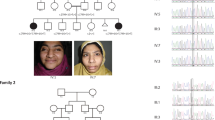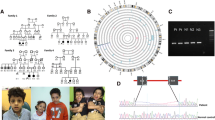Abstract
Intellectual disability (ID) is one of the most common disabilities and, although many genes have been implicated in its etiology, the genetic heterogeneity of ID continues to expand. The purpose of the study was to describe a novel autosomal recessive non-syndromic ID locus. Autozygome and linkage analysis, and exome sequencing followed by RNA and protein analysis of the candidate disease gene were performed. We describe two multiplex consanguineous families with non-syndromic ID phenotype, which maps to a critical linkage locus on 3q26. Exome sequencing of the index in each family revealed the same homozygous truncating mutation in TNIK that results in complete loss of the protein. TNIK is a kinase with a well-established role in dendrite development and synaptic transmission. The phenotype we observe in human patients who lack TNIK is consistent with the previously published Tnik −/− phenotype in the murine model. Our data strongly implicate TNIK deficiency in the causation of ID in humans.



Similar content being viewed by others
References
Alkuraya FS (2010) Autozygome decoded. Genet Med 12:765–771
Alkuraya FS (2012) Discovery of rare homozygous mutations from studies of consanguineous pedigrees. Curr Protoc Hum Genet 6.12:1–6.12. 13
Alkuraya FS (2013) The application of next-generation sequencing in the autozygosity mapping of human recessive diseases. Hum Genet 132:1197–1211
Alkuraya FS (2015) Human knockout research: new horizons and opportunities. Trends Genet 31:108–115
Al-Qattan SM, Wakil SM, Anazi S, Alazami AM, Patel N, Shaheen R, Shamseldin HE, Hagos ST, AlDossari HM, Salih MA, El Khashab HY, Kentab AY, AlNasser MN, Bashiri FA, Kaya N, Hashem MO, Alkuraya FS (2015) The clinical utility of molecular karyotyping for neurocognitive phenotypes in a consanguineous population. Genet Med 17(9):719–725
American Psychiatric Association (2013) Diagnostic and Statistical Manual of Mental Disorders, 5th edn. Arlington, Virginia
Ayalew M, Le-Niculescu H, Levey D, Jain N, Changala B, Patel S, Winiger E, Breier A, Shekhar A, Amdur R (2012) Convergent functional genomics of schizophrenia: from comprehensive understanding to genetic risk prediction. Mol Psychiatry 17:887–905
Burette AC, Phend KD, Burette S, Lin Q, Liang M, Foltz G, Taylor N, Wang Q, Brandon NJ, Bates B, Ehlers MD, Weinberg RJ (2015) Organization of TNIK in dendritic spines. J Comp Neurol 523(13):1913–1924
Coba MP, Komiyama NH, Nithianantharajah J, Kopanitsa MV, Indersmitten T, Skene NG, Tuck EJ, Fricker DG, Elsegood KA, Stanford LE (2012) TNiK is required for postsynaptic and nuclear signaling pathways and cognitive function. J Neurosci 32:13987–13999
de Ligt J, Willemsen MH, van Bon BW, Kleefstra T, Yntema HG, Kroes T, Vulto-van Silfhout AT, Koolen DA, de Vries P, Gilissen C (2012) Diagnostic exome sequencing in persons with severe intellectual disability. N Engl J Med 367:1921–1929
Elia J, Glessner JT, Wang K, Takahashi N, Shtir CJ, Hadley D, Sleiman PM, Zhang H, Kim CE, Robison R (2012) Genome-wide copy number variation study associates metabotropic glutamate receptor gene networks with attention deficit hyperactivity disorder. Nat Genet 44:78–84
Fu CA, Shen M, Huang BC, Lasaga J, Payan DG, Luo Y (1999) TNIK, a novel member of the germinal center kinase family that activates the c-Jun N-terminal kinase pathway and regulates the cytoskeleton. J Biol Chem 274:30729–30737
Gilissen C, Hehir-Kwa JY, Thung DT, van de Vorst M, van Bon BW, Willemsen MH, Kwint M, Janssen IM, Hoischen A, Schenck A, Leach R, Klein R, Tearle R, Bo T, Pfundt R, Yntema HG, de Vries BB, Kleefstra T, Brunner HG, Vissers LE, Veltman JA (2014) Genome sequencing identifies major causes of severe intellectual disability. Nature 511(7509):344–347
Hoffmann K, Lindner TH (2005) easyLINKAGE-Plus—automated linkage analyses using large-scale SNP data. Bioinformatics 21:3565–3567
Hussain NK, Hsin H, Huganir RL, Sheng M (2010) MINK and TNIK differentially act on Rap2-mediated signal transduction to regulate neuronal structure and AMPA receptor function. J Neurosci 30:14786–14794
Kyriakis JM (1999) Signaling by the germinal center kinase family of protein kinases. J Biol Chem 274:5259–5262
Mahmoudi T, Li VS, Ng SS, Taouatas N, Vries RG, Mohammed S, Heck AJ, Clevers H (2009) The kinase TNIK is an essential activator of Wnt target genes. EMBO J 28:3329–3340
Maulik PK, Harbour CK (2013) Epidemiology of intellectual disability. International Encyclopedia of Rehabilitation [online]
Mikryukov A, Moss T (2012) Agonistic and antagonistic roles for TNIK and MINK in non-canonical and canonical Wnt signalling. PLoS One 7(9):e43330. doi:10.1371/journal.pone.0043330
Miller DT, Adam MP, Aradhya S, Biesecker LG, Brothman AR, Carter NP, Church DM, Crolla JA, Eichler EE, Epstein CJ (2010) Consensus statement: chromosomal microarray is a first-tier clinical diagnostic test for individuals with developmental disabilities or congenital anomalies. Am J Hum Genet 86:749–764
Narayan S, Nakajima K, Sawa A (2013) DISC1 A key lead in studying cortical development and associated brain disorders. Neuroscientist 19:451–464
Peng J, Kim MJ, Cheng D, Duong DM, Gygi SP, Sheng M (2004) Semiquantitative proteomic analysis of rat forebrain postsynaptic density fractions by mass spectrometry. J Biol Chem 279(20):21003–21011
Potkin SG, Turner JA, Guffanti G, Lakatos A, Fallon JH, Nguyen DD, Mathalon D, Ford J, Lauriello J, Macciardi F (2009) A genome-wide association study of schizophrenia using brain activation as a quantitative phenotype. Schizophr Bull 35:96–108
Rauch A, Wieczorek D, Graf E, Wieland T, Endele S, Schwarzmayr T, Albrecht B, Bartholdi D, Beygo J, Di Donato N (2012) Range of genetic mutations associated with severe non-syndromic sporadic intellectual disability: an exome sequencing study. Lancet 380:1674–1682
Saudi Mendeliome Group (2015) Comprehensive gene panels provide advantages over clinical exome sequencing for Mendelian diseases. Genome Biol 16:134
Taira K, Umikawa M, Takei K, Myagmar B-E, Shinzato M, Machida N, Uezato H, Nonaka S, Kariya KI (2004) The Traf2-and Nck-interacting kinase as a putative effector of Rap2 to regulate actin cytoskeleton. J Biol Chem 279:49488–49496
Wang Q, Charych E, Pulito V, Lee J, Graziane N, Crozier R, Revilla-Sanchez R, Kelly M, Dunlop A, Murdoch H (2011) The psychiatric disease risk factors DISC1 and TNIK interact to regulate synapse composition and function. Mol Psychiatry 16:1006–1023
Acknowledgments
We thank the families for their enthusiastic participation. We thank the Genotyping Core Facility at KFSHRC for their technical help. This work was supported in part by KACST Grant 13-BIO1113-20 (FSA).
Author information
Authors and Affiliations
Corresponding authors
Ethics declarations
Conflict of interest
The authors declare no conflict of interest.
Additional information
S. Anazi, H. E. Shamseldin and D. AlNaqeb contributed equally.
Electronic supplementary material
Below is the link to the electronic supplementary material.
439_2016_1671_MOESM1_ESM.pdf
Supplementary material 1 (PDF 1677 kb) Figure S1. AutoSNPa output showing the six shared homozygous block in Family-1 and the single shared homozygous block in Family-2. Figure S2. TNIK RT-PCR revealed stable TNIK mutant transcript
Rights and permissions
About this article
Cite this article
Anazi, S., Shamseldin, H.E., AlNaqeb, D. et al. A null mutation in TNIK defines a novel locus for intellectual disability. Hum Genet 135, 773–778 (2016). https://doi.org/10.1007/s00439-016-1671-9
Received:
Accepted:
Published:
Issue Date:
DOI: https://doi.org/10.1007/s00439-016-1671-9




